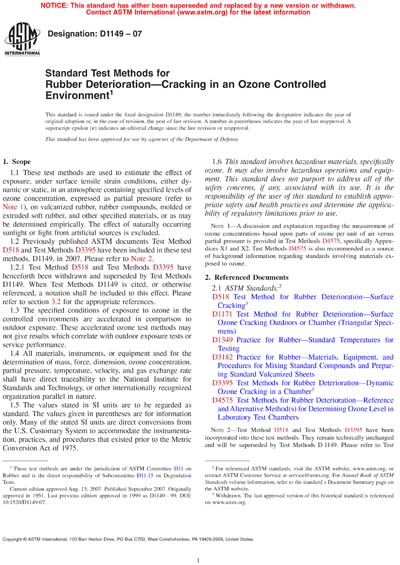Historical
ASTM D1149-07
Standard Test Methods for Rubber Deterioration-Cracking in an Ozone Controlled Environment
1.1 These test methods are used to estimate the effect of exposure, under surface tensile strain conditions, either dynamic or static, in an atmosphere containing specified levels of ozone concentration, expressed as partial pressure (refer to Note 0), on vulcanized rubber, rubber compounds, molded or extruded soft rubber, and other specified materials, or as may be determined empirically. The effect of naturally occurring sunlight or light from artificial sources is excluded.
1.2 Previously published ASTM documents Test Method D 518 and Test Methods D 3395 have been included in these test methods, D 1149, in 2007. Please refer to Note 0.
1.2.1 Test Method D 518 and Test Methods D 3395 have henceforth been withdrawn and superseded by Test Methods D 1149. When Test Methods D 1149 is cited, or otherwise referenced, a notation shall be included to this effect. Please refer to section for the appropriate references.
1.3 The specified conditions of exposure to ozone in the controlled environments are accelerated in comparison to outdoor exposure. These accelerated ozone test methods may not give results which correlate with outdoor exposure tests or service performance.
1.4 All materials, instruments, or equipment used for the determination of mass, force, dimension, ozone concentration, partial pressure, temperature, velocity, and gas exchange rate shall have direct traceability to the National Institute for Standards and Technology, or other internationally recognized organization parallel in nature.
1.5 The values stated in SI units are to be regarded as standard. The values given in parentheses are for information only. Many of the stated SI units are direct conversions from the U.S. Customary System to accommodate the instrumentation, practices, and procedures that existed prior to the Metric Conversion Act of 1975.
This standard involves hazardous materials, specifically ozone. It may also involve hazardous operations and equipment. This standard does not purport to address all of the safety concerns, if any, associated with its use. It is the responsibility of the user of this standard to establish appropriate safety and health practices and determine the applicability of regulatory limitations prior to use.
Note 1A discussion and explanation regarding the measurement of ozone concentrations based upon parts of ozone per unit of air versus partial pressure is provided in Test Methods D 4575, specifically Appendices X1 and X2. Test Methods D 4575 is also recommended as a source of background information regarding standards involving materials exposed to ozone.
Content Provider
ASTM International [astm]






